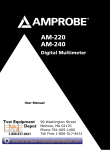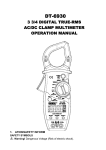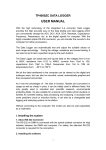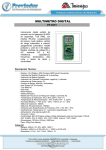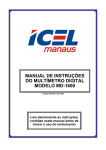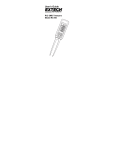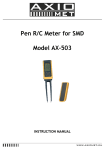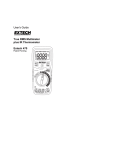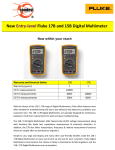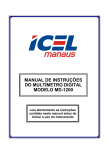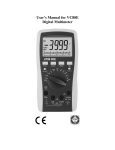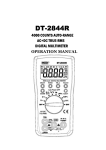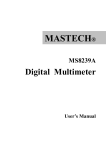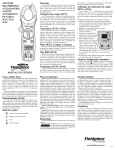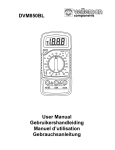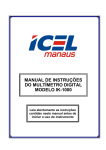Download am-220 & am-240 digital multimeter operation
Transcript
AM-220 & AM-240 DIGITAL MULTIMETER OPERATION 1 MANUAL 1. SAFETY INFORMATION SAFETY SYMBOLS Warning! Dangerous Voltage (Risk of electric shock). Caution! Refer to the user’s manual before using this Meter. Double Insulation (Protection Class II). Alternating Current (AC). Direct Current (DC). Either DC or AC. Ground (maximum permitted voltage between terminal and ground). The RESPONSIBLE BODY shall be made aware that, if the instrument is used in a manner not specified by the manufacturer, the protection provided by the instrument may be impaired. The finger or any part of your body shall not be beyond the barrier of the test probe when measuring. The following safety information must be observed to insure maximum personal safety during the operation at this meter. 1.1 Do not operate the meter if the body of meter or the test leads look broken. 1.2 Check the rotary selector switch to make sure it is at the correct position before each measurement. 1.3 When making current measurements ensure that the circuit has no voltage before opening it in order to connect the test leads. 1.4 Do not perform resistance, capacitance, temperature, diode and continuity test when voltage is present. 1.5 Do not apply voltage between the test terminals and test terminal to ground that exceed the maximum limit record in this manual. 1.6 Exercise extreme caution when measuring live system with voltage greater than 60V DC or 30V AC. 1.7 Change the battery when the “ ” symbol appears to avoid incorrect data. 2. SPECIFICATIONS 2.1 GENERAL SPECIFICATIONS Display: LCD with a max. reading of 4000. Range control: Auto range & Manual range control Polarity: Automatic negative polarity indication. Zero adjustment: Automatic. 2 Overrange indication: The “OL” or “-OL” display. Low battery indication: Display " " sign. Data hold: Display “ ” sign. Relative measurement: Display “!” sign. Auto Power Off: Display “ ” sign. After 10 minutes without switching modes or pressing a key the meter will switch to standby mode. Press any key or switch selector switch to exit standby mode. To disable auto power off, press and hold SELECT key while rotating the selector switch from off position. Safety standards: EMC/LVD. The meter is up to the standards of IEC1010 Double Insulation, Pollution Degree 2, Overvoltage Category III. Operating environment: Temperature 32 to104°F (0°C to 40°C), Humidity °‹ 80% RH. Storage environment: Temperature -4 to140°F (-20°C to 60°C), Humidity °‹ 90% RH. Power supply: 2x1.5V “AA” batteries. Dimension: 156(H) x 86(W) x 38(D) mm Weight: Approx. 260g (including battery). 2.2 ELECTRICAL SPECIFICATIONS Accuracies are ±(% of reading + number in last digit) at 23 ± 5°C,°‹75% RH. 2.2.1 DC VOLTAGE Range Accuracy Resolution 400mV 0.1mV ± ( 0.5%+2 ) 4V 1mV 40V 10mV 400V 100mV 600V ± ( 0.8%+3 ) 1V Overload protection: 600V DC or AC RMS Impedance: 10MΩ, More than 100MΩ on 400mV range 2.2.2 AC VOLTAGE Range Accuracy Resolution 400mV ± ( 1.5%+3 ) 0.1mV 4V 1mV ± ( 1.0%+2 ) 40V 10mV 400V 100mV 600V ± ( 1.5%+3 ) 1V Average sensing, calibrated to RMS of sine wave Frequency: 40 ~ 400Hz Overload protection: 600V DC or AC RMS Impedance: 10MΩ , More than 100MΩ on 400mV range 3 2.2.3 DC CURRENT Range Accuracy Resolution 400µA 0.1µA ± ( 1.2%+3 ) 4000µA 1µA 40mA 10µA 400mA 100µA 4A ± ( 2.0%+5 ) 1mA 10A 10mA Overload protection: 0.5A/250V, 10A/250V fuse 2.2.4 AC CURRENT Range Accuracy Resolution 400µA 0.1µA ± ( 1.5%+3 ) 4000µA 1µA 40mA 10µA 400mA 100µA 4A ± ( 2.5%+5 ) 1mA 10A 10mA Average sensing, calibrated to RMS of sine wave Frequency: 40~400Hz Overload protection: 0.5A/250V, 10A/250V fuse 2.2.5 RESISTANCE Range Accuracy Resolution 400Ω 0.1Ω 4kΩ 1Ω ± ( 1.0%+2 ) 40kΩ 10Ω 400kΩ 100Ω 4MΩ 1kΩ 40MΩ ± ( 2.0%+3 ) 10kΩ Overload protection: 250V DC or AC RMS 2.2.6 CAPACITANCE Range Accuracy 40nF ± ( 3.0%+10 ) 400nF ± ( 2.5%+5 ) 4µF 40µF 400µF ± ( 5.0%+10 ) 4000µF ± ( 20.0%+20 ) Resolution 10pF 100pF 1nF 10nF 100nF 1µF 4 Overload protection: 250V DC or AC RMS 2.2.7 DIODE AND AUDIBLE CONTINUITY TEST Range Description Test condition Display read Forward DC current approximately approx. 0.4mA forward voltage Reversed DC of diode voltage approx. 2.8V Built-in buzzer Open circuit voltage sounds if approx. 0.5V resistance is less than 50_ Overload protection: 250V DC or AC RMS 2.2.8 FREQUENCY Range Accuracy Resolution 10Hz 0.01Hz 100Hz 0.1Hz 1000Hz 1Hz ± ( 0.1%+5 ) 10kHz 10Hz 100kHz 100Hz 1000kHz 1kHz 10MHz 10kHz Sensitivity: sine wave 0.6V RMS (10MHz: 1.5V RMS) Overload protection: 250V DC or AC RMS 2.2.9 DUTY CYCLE 0.1% ~ 99.9%: ± (2.0%+2) Frequency lower than 10kHz Sensitivity: sine wave 0.6V RMS Overload protection: 250V DC or AC RMS 5 2.2.10 TEMPERATURE (AM-240 ONLY) - Accuracy specification is relative to the user-adjustable temperature offset, and assumes ambient temperature stable to ± 1°C. - For ambient temperature changes of ± 5°C, rated accuracy applies after 1 hour. - Does not include error of the thermocouple probe Range -58ºF ~ +1292ºF -50ºC ~ +700ºC Accuracy +/-(1% + 3ºF) +/-(1% + 2ºC) Resolution 1° /1°F Overload protection: 250V DC or AC RMS 3. OPERATION 3.1 DC VOLTAGE MEASUREMENT 1) Connect the black test lead to "COM" socket and red test lead to the "VΩ mA" socket. 2) Set the selector switch to “V ” position. 3) Measure the voltage by touch the test lead tips to the test circuit where the value of voltage is needed. 4) Read the result from the LCD panel. 3.2 AC VOLTAGE MEASUREMENT 1) Connect the black test lead to "COM" socket and red test lead to the "VΩ mA" socket. 2) Set the selector switch to “V ” position. 3) Measure the voltage by touch the test lead tips to the test circuit where the value of voltage is needed. 4) Read the result from the LCD panel. 3.3 DC AND AC CURRENT MEASUREMENT 1) Connect the black test lead to "COM" socket. For measurement up to 400mA, connect the red test lead to the "VΩmA" socket; for measurement from 400mA to 10A, connect the red test lead to the "10A" socket 2) Set the selector switch to desired “µA ”, “mA ” or “A ” position. 3) Press “SELECT” key to choose “DC” or “AC” measurement. 4) Remove power from the circuit under test and open the normal circuit path where the measurement is to be taken. Connect the meter in series with the circuit. 5) Read the result from the LCD panel. 6 3.4 RESISTANCE MEASUREMENT 1) Connect the black test lead to "COM" socket and red test lead to the "VΩmA" socket. 2) Set the selector switch to desired “ ” position. 3) Connect tip of the test leads to the points where the value of the resistance is needed. 4) Read the result from the LCD panel. Note: When measuring resistance values from a circuit, make sure the power is off and discharge all capacitors. 3.5 CAPACITANCE MEASUREMENT 1) Connect the black test lead to "COM" socket and red test lead to the "VΩ mA" socket. 2) Set the selector switch to desired “ ” position. 3) Press “SELECT” key to choose Capacitance measurement. 4) Connect tip of the test leads to the points where the value of the capacitance is needed. 5) Read the result from the LCD panel. Note: a) Before testing, discharge the capacitor by shorting its leads together. Use caution in handling capacitors because they may have a charge on them of considerable power. b) Before testing, press “REL !” key to eliminate the zero error. c) When testing 4000µF capacitor, note that there will be approx. 30 seconds time lag. 3.6 DIODE AND AUDIBLE CONTINUITY TEST 1) Connect the black test lead to "COM" socket and red test lead to the "VΩ mA" socket. 2) Set the selector switch to desired “ ” position. 3) Press “SELECT” key to choose Diode or Audible Continuity measurement. 4) Connect the test leads across the diode under test, display measures the approx. forward voltage of this diode. 5) Connect the test leads to two point of circuit, if the resistance is lower than approx. 50Ω, the buzzer sounds. Note: Make sure the power is cut off and all capacitors need to be discharged under this measurement. 7 3.7 FREQUENCY AND DUTY CYCLE MEASUREMENT 1) Connect the black test lead to "COM" socket and red test lead to the "VΩmA" socket. 2) Set the selector switch to desired “Hz” position. 3) Press “Hz%” key to choose Frequency or Duty cycle measurement. 4) Connect the probe across the source or load under measurement. 5) Read the result from the LCD panel. 3.8 TEMPERATURE MEASUREMENT 1) Set the selector switch to desired “°F/ °C” position. 2) Press “SELECT” key to choose °F or °C measurement. 3) There is an internal PN Junction Diode Sensor which measures ambient temperature with no probe connected. This is the 0~40° in the spec. 4) Connect the probe included, or any K-type thermocouple, by inserting the “+” plug in the "VΩmA" socket & the “-“ in the "COM" socket 5) Put the sensor probe into the temperature field under measurement. 3.9 DATA HOLD AND BACK LIGHT On any range, press the “ ” key to lock display value, and the “ ” sign will appear on the display, press it again to exit. On any range, press the “ ” key for more than 2 seconds to light the back light, press it again for more than 2 seconds to wink the light. 3.10 MAX/MIN HOLD Press the “MAX/MIN” key to lock MAX or MIN value, and the “MAX” or “MIN” sign will appear on the display, press it for more than 2 seconds to exit. 3.11 RELATIVE MEASUREMENT Press the “REL !” key, you can measure the relative value and “!” sign will appear on the display, the auto range mode be changed to manual range mode. Press it again to exit relative measurement and “!” sign disappears, but you cannot go back to auto range mode. This function is non effective on Hz% measurement. 3.12 AUTO/MANUAL RANGE The auto range mode is a convenient function, but it might be faster to manually set the range when you measure values that you know to be within a certain range. To select manual range, repeatedly press “RANGE” key until the display shows the desired range. The range steps upward as you press “RANGE” key. The meter will go back to auto range mode when you press “RANGE” key for more than 2 seconds. It can not select manual range mode on Hz%, capacitance and temperature range. Caution: while using the manual range mode, if “OL” sign appears on the display, immediately set range to a higher. 8 4. BATTERY REPLACEMENT 1) When the battery voltage drops below proper operating range, the “ ” symbol will appear on the LCD and the batteries needs to be changed. 2) Before changing the batteries, set the selector switch to “OFF” position. Remove the two screws on the bottom case and lift the bottom case. 3) Replace the old batteries with the same type battery. 4) Close the bottom case and fasten the screw. 5. FUSE REPLACEMENT 1) This meter is provided with a 0.5A/250V fuse to protect the current measuring circuits that measure up to 400mA, with a 10A/250V fuse to protect the 10A range. 2) Ensure the instrument is not connected to any external circuit, set the selector switch to “OFF” position and remove the test leads from the terminals. 3) Remove the two screws on the bottom case and lift the bottom case. Replace the old fuse with the same type and rating: 5x20mm 0.5A/250V or 6x32mm 10A/250V fuse. 4) Close the bottom case and fasten the screws. 6. MAINTENANCE 1) Before opening the bottom case, disconnect both test leads and never use the meter before the bottom case is closed. 2) To avoid contamination or static damage, do not touch the circuit board without proper static protection. 3) If the meter is not going to be used for a long time, take out the batteries and do not store the meter in high temperature or high humidity environment. 4) Repairs or servicing not covered in this manual should only by qualified personnel. 5) Periodically wipe the case with a dry cloth and detergent. Do not use abrasives or solvents on the meter. LIMITED WARRANTY Congratulations! Your new instrument has been quality crafted according to quality standards and contains quality components and workmanship. It has been inspected for proper operation of all of its functions and tested by qualified factory technicians according to the long-established standards of our company. Your instrument has a limited warranty against defective materials and/or workmanship for one year from the date of purchase provided that, in the opinion of the factory, the instrument has not been tampered with or taken apart. Should 9 your instrument fail due to defective materials, and/or workmanship during this one year period, a no charge repair or replacement will be made to the original purchaser. Please have your dated bill of sale, which must identify the instrument model number and serial number and call the number listed below: Repair Department ATP – Amprobe Phone: 954-499-5400 Toll Free: 800-327-5060 Fax: 866-287-7222 Website: www.Amprobe.com Please obtain an RMA number before returning product for repair. Outside the U.S.A. the local representative will assist you. Above limited warranty covers repair and replacement of instrument only and no other obligation is stated or implied. www.Amprobe.com 10










